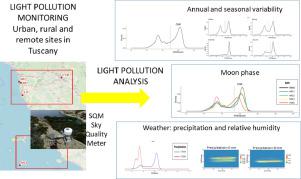Journal of Quantitative Spectroscopy and Radiative Transfer ( IF 2.3 ) Pub Date : 2020-08-09 , DOI: 10.1016/j.jqsrt.2020.107250 Luciano Massetti

|
Light pollution generated by the excessive use of artificial light at night is an environmental and ecological concern. Artificial light at night is diffused far from the sources, for long distances by scattering in the atmosphere (skyglow), thus affecting the night sky and the biodiversity of rural and natural areas. The characterization of the level and variability of light pollution has become an important issue for several disciplines.
This study analyzes light pollution in urban, rural and remote sites in Tuscany (Italy) by monitoring night sky brightness. Night sky brightness (NSB) data collected from 2016 to 2019 were analyzed to assess annual and seasonal variability at each site and between sites. The relationship between night sky brightness and moonlight and weather conditions were also analyzed. Trend analysis was also performed to evaluate the degradation of the quality of the measurement with time due to dirty accumulation on the sensor shield.
NSB in Tuscany during moonless nights ranged between 17.3 and 21.8 mpsas. The monthly cycle of moonlight is the main driver of night sky brightness variability in the remote site (21.8 mpsas on moonless nights and 18.5 mpsas on full moon nights) with a slight, but significant darkening effect during rainy conditions (22.3 mpsas). In urban sites, moonlight cycle is almost completely masked by weather conditions, as it can be seen from the analysis of seasonal variability, lunar monthly cycle analysis and weather condition analysis. Average night sky brightness on rainy days might reach 15.4 mpsas (approximately 436 times brighter than the natural background), an intensity that is even higher than average night sky brightness in full moonlight at the same site (16.6 mpsas). Light pollution can reach levels that might affect nocturnal species, and therefore the study of long term variability of light pollution is important for ecological studies.
中文翻译:

城市,农村和偏远地区夜间多变的人造光驱动器
晚上过度使用人造光产生的光污染是环境和生态问题。夜间的人造光会通过散布在大气中(天窗)而远离光源扩散很长的距离,从而影响夜空以及农村和自然地区的生物多样性。对光污染水平和变异性的表征已成为几门学科的重要课题。
这项研究通过监测夜空亮度分析了意大利托斯卡纳的城市,农村和偏远地区的光污染。分析了2016年至2019年收集的夜空亮度(NSB)数据,以评估每个站点以及站点之间的年度和季节性变化。还分析了夜空亮度和月光与天气状况之间的关系。还进行了趋势分析,以评估由于传感器护罩上的脏污积累而导致的测量质量随时间的下降。
托斯卡纳的NSB在无月之夜的航程为17.3至21.8 mpsas。月度的月度周期是偏远地区夜空亮度变化的主要驱动因素(无月夜为21.8 mpsas,满月夜为18.5 mpsas),在下雨天(22.3 mpsas)有轻微但明显的变暗作用。在城市地区,从季节性变化分析,月度月度周期分析和天气状况分析可以看出,天气条件几乎完全掩盖了月光周期。雨天的平均夜空亮度可能达到15.4 mpsas(约为自然背景亮度的436倍),该强度甚至高于同一地点满月光下的平均夜空亮度(16.6 mpsas)。光污染可能达到可能影响夜间物种的水平,











































 京公网安备 11010802027423号
京公网安备 11010802027423号